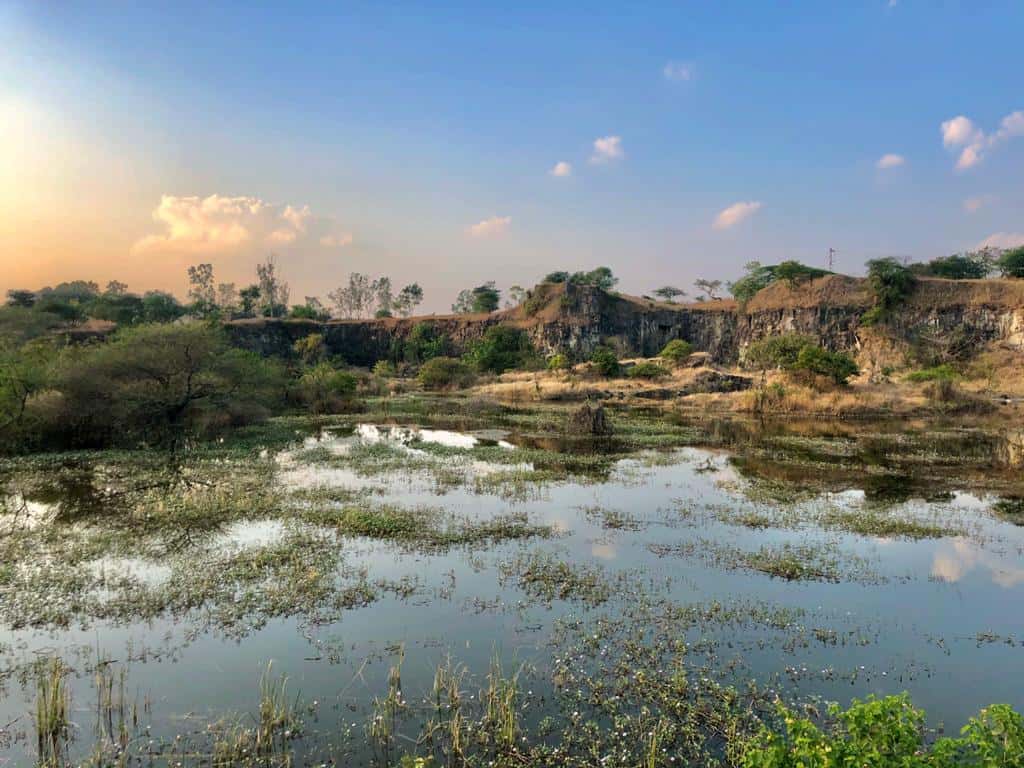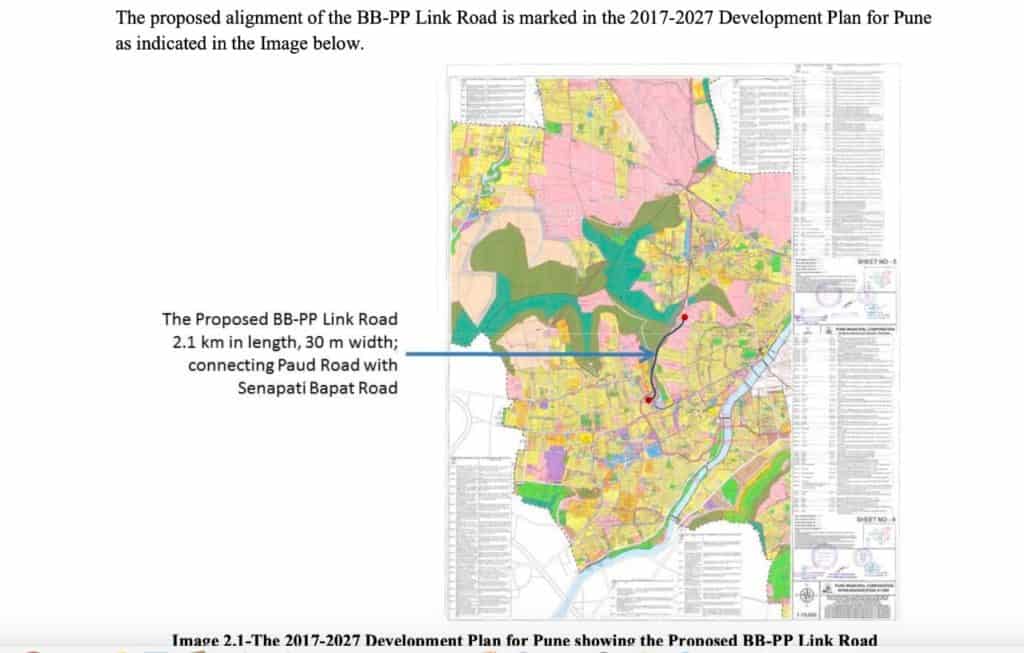The draft Environmental Impact Assessment (EIA) turns the original 2006 EIA notification on its head. While the earlier notification had made environment impact assessment a precondition for any project to get started, the new draft allows industries to get started on their projects in violation of EIA norms and then seek clearance. And Pune’s green activists are adding their voice to the countrywide criticism of the new draft.
Pune’s fight is against the Bal Bharati-Paud Phata link road that cuts through the Law College hill. The justification given by the Pune Municipal Corporation (PMC) is that this 2.1 km link road will help in decongesting Law College Road (and Senapati Bapat Road, Ganeshkhind Road) .
But the citizens’ group which has filed a Public Interest Litigation (PIL) in the Bombay High Court against the proposed link road are not buying the argument.
The Bal Bharati-Paud Phata (BB-PP) link road was first proposed in 1987. Citizen groups and environmentalists have always opposed the project as the road passes through Vetal Tekadi (Vetal hill) and the slopes of Law College Tekadi.
Vetal Tekadi could be considered the green lungs of Pune city with its hill slopes sprouting dense vegetation patches, open scrubs, deciduous forests and plantation areas. The tekadi is a popular hiking and walking destination for Pune’s citizens.
The road cutting through this tekadi was approved under Section 205 of Bombay Municipal Corporation Act (BPMC) in 2005. But no work has happened so far on the road link, which on the date of approval was estimated to cost Rs 24 crore.
High Court verdict
In 2006, Maj Gen SCN Jatar (retd), President Emeritus of Pune’s Nagarik Chetana Manch (NCM) filed the PIL challenging the approval in the Bombay High Court, which in 2016 struck down the construction. The NCM, on its website says the High Court ruled that the authority did not “apply its mind to the environmental aspect while approving it.”
Hence, the NCM also demanded that if the road construction has to progress, the PMC must apply its mind to the environmental aspect and establish the need for the road.
“The PMC acceded to our request and agreed to consult with the Manch, Parisar, Pedestrian First and Centre for Development Studies and Activities (comprising the Expert Committee formed by the Commissioner in June 2007) at every stage of planning. A member each from Pedestrian First and NCM are members of the Tender Committee representing the Expert Committee.”
Nagarik Chetana Manch, Pune
Finally, the PMC gave the contract for EIA to VK:e, a company which promotes sustainability and has Green Building Certifications, International Certifications and does Environmental Clearance and EIA Studies. The report on traffic study was given to Sustainancy Consultants, which works in the areas of Urban Transport Planning, Information Technology, in January 2019. Both reports were to be submitted in 20 weeks.
Maj Gen Jatar, a member of Expert Committee, pointed out that the BB-PP link road would cover:
- Survey No 44 (part of this is Hill Top and Hill Slope zone)
- Survey Nos 49+50+51+52+53 (Deemed Forest, Hill Top, Hill Slope zone in DP map, but the Deputy Conservator of Forests said this was Deemed Forest in his letter to the Collector in 2001)
- Survey no 97 Law College campus (public, semi-public zone)
- Survey no 150 Bhandarkar Institute campus (public, semi-public zone)
- Survey no 94 (Reserved Forest land, but only the last tiny bit).
“The alignment skirts around a hill starting from Bal Bharati on Senapati Bapat Road and ends at Paud Junction on Karve Road,” explained Jatar.

Environmental impact
“Only one public participation meeting was called, which did not cover all the localities, where the stakeholders are residing,” said Jatar when asked about the public participation meetings called by VK:e. “Both the environment and traffic consultants gave their findings in brief and the status of their reports. The consultants had assured the attendees that their suggestions would be considered after discussion with the PMC. This was not done.”
There was a clear divide during the meeting with the local councillors and their few supporters making a fervent pitch for the road on the ground that the Law College Road’s volume to capacity ratio had been exceeded and that residents staying in the area were suffering from acute air pollution.
However, a majority of citizens contended that constructing a road here would cause long term damage to both environment and the water aquifers. This proposed road will plug the recharge area that is contributing the water to the aquifer, they argue.
While Pune’s water supply is not dependent on this acquifer, activists argue that the groundwater table will be impacted if the road comes through.
Sushma Date, a member of the Deccan Gymkhana Parisar Samiti, had attended the public meeting of EIA. Speaking on the aquifer issue, Sushma said: “Himanshu Kulkarni of ACWADAM (Advanced Center for Water Resources Development and Management) has studied the groundwater levels in the city, and they have also released their study of 10 years. The study says that out of the five main aquifers that supplies water to Pune, the largest is below the Vetal Tekadi-Chatushringi complex. So if a road is constructed above the aquifer, groundwater levels will be impacted.”

Road will only worsen pollution
The activists also fear that the link road would lead to more traffic and pollution. “It is a well recognised principle that if you widen and build more roads, traffic increases proportionately, it doesn’t reduce,” said Sushma Date.
Sushma also pointed out that if this road is constructed, there will be a new bottleneck at Khandekar Chowk. On Paud Phata, Pune Metro’s construction work is going on and the new road will lead to more congestion. Therefore this whole argument about cutting down on travel time is not correct. “You will probably save 2-3 minutes and not 10-15 minutes as claimed by PMC. And for those 2-3 minutes, you are destroying a hill,” she said.
There are also concerns that the link road will increase construction activity in the areas it passes through. “That is precisely our apprehension because roads invariably bring about development of the area i.e. building construction,” said Jatar. “Presently, there is a ban on construction activities in this area being partly forest. However, these restrictions can be easily lifted once the road comes into being.
“As of today, the alignment passes through a deemed forest, which is a no-construction zone. Which means the road cannot be constructed without the approval of the Government of India’s Ministry of Environment, Forest & Climate Change.”
The Expert Committee sent its views to the PMC in January 2020 but “there has been no response probably due to the pandemic,” added Jatar. Though V G Kulkarni of PMC’s Road Department said “the EIA report of BB-PP hasn’t come yet and no public participation meetings have been planned for another five or six months.”
“If this road is constructed, there will be a new bottleneck at Khandekar Chowk…You will probably save 2-3 minutes and not 10-15 minutes as claimed by PMC. And for those 2-3 minutes, you are destroying a hill“
Sushma Date, Deccan Gymkhana Parisar Samiti
Significance of the hills
“The tekadis are a critical piece of urban green space housing a truck load of biodiversity, which, in turn provides the citizens a host of regulatory and cultural ecosystem services,” says Ashish Nerlekar, a graduate student, Veldman lab Department of Ecosystem Science & Management, Texas A&M University, USA. “Though perception and motivations for afforestation have surely changed over time. It started with a timber focussed motivation in colonial times, to a forage/shade provisioning phase post-independence, to a more native tree plantations phase in the last few decades.”
Jatar says that the proposed road passes through natural areas and habitats supporting its specific flora and fauna like hill slopes, dense vegetation patches, open scrubs, deciduous forests and plantation areas.
Many rare and endangered species exist on Law College hill and in the surrounding areas of Vetal Hill:
- There are 49 species of flora like Babul, Hivar, Chandan, Khair, Medhashingi, Moi, Gliricindia, Subabul, Kadulimb, Erand, Badam, Bamboo, Gulmohor, Jambhul and Bartond
- There are 45 species of fauna and some of these are butterflies, reptiles and mammals.
- There are 134 species of birds in the area.
Jatar is sceptical of the mitigation measures PMC will have to undertake in view of trees having to cut to make way for the road.
Some facts
- The number of trees to be cut is 1,445 according to this study
- Five times this number i.e. 7,225 trees would need to be planted as compensatory afforestation
- Additionally, Schedule I of the Trees Rules 2009 mandates planting of one tree at 10 meters interval on both sides of the road with a suitable hedge on the median. Thus 420 additional trees would have to be planted.
Jatar also points out that as per National Green Tribunal directions, these trees are to be in the vicinity of the area from where trees have been cut. It appears a formidable task not only to find suitable places to plant but also to ensure that the trees would survive. PMC’s record in this regard is wanting. There are no specific directions in the mitigation plan for suitable locations.
Given all these issues, is the link road really necessary? The unanimous answer from environmentalists is no, who insist that the city needs to improve its public transport system instead. “From what I have read so far, I am yet to see a valid, logical, and ecologically sound argument to have this road through the hills,” said Nerlekar. “A comprehensive, science driven understanding is needed to figure out alternatives”.
“We have suggested many times to improve the Pune Mahangar Parivahan Mahamandal Ltd (PMPL) bus service, to include more feeder bus services to operate in lanes, but to no avail,” added Sushma Date.
True, there are other roads in Pune which are causing worse environmental pollution. However, there is no hill near these to encroach upon. “Pollution can be brought under control in a sustained manner only if public transport is improved,” echoed Jatar. “However the aim of our ruling elite is to spend large sums of money in the name so-called development which are not in public interest”.